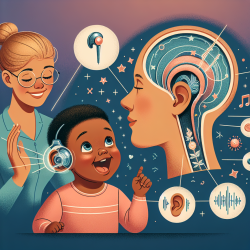Understanding Cochlear Implants and Single-Sided Deafness
For practitioners in the field of special education and audiology, understanding the impact of cochlear implants on children with single-sided deafness (SSD) is crucial. The research article titled Cortical organization restored by cochlear implantation in young children with single sided deafness provides valuable insights into how early cochlear implantation can restore auditory cortical organization in young children.
Key Findings from the Research
The study focused on a group of five young children with normal hearing in one ear and SSD in the other, primarily due to cytomegalovirus. These children received cochlear implants in their deaf ears, and their cortical activity was monitored over several months. The research found that:
- Early cochlear implantation can rapidly restore bilateral auditory input, crucial for binaural hearing.
- Chronic use of cochlear implants led to normalized cortical responses and improved auditory processing.
- Children showed a shift from abnormal ipsilateral cortical lateralization to expected contralateral lateralization with chronic implant use.
Implications for Practitioners
For practitioners, these findings highlight the importance of early intervention in children with SSD. Implementing cochlear implants at a young age can significantly enhance auditory development and prevent long-term deficits associated with single-sided hearing. Here are some ways practitioners can apply these findings:
- Early Diagnosis and Intervention: Encourage early hearing assessments and consider cochlear implantation as a viable option for children diagnosed with SSD.
- Continuous Monitoring: Regularly monitor the auditory development of children with cochlear implants to ensure optimal outcomes.
- Collaborative Approach: Work closely with audiologists, speech therapists, and families to create a comprehensive care plan for children with SSD.
Encouraging Further Research
While this study provides significant insights, further research is essential to explore long-term outcomes and the potential for cochlear implants to enhance spatial hearing and speech perception. Practitioners are encouraged to stay updated with the latest research and consider participating in studies that contribute to this evolving field.
To read the original research paper, please follow this link: Cortical organization restored by cochlear implantation in young children with single sided deafness.










